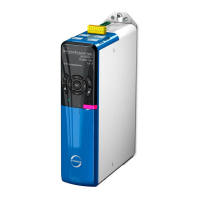8 | Commissioning STOBER
30
02/2020 | ID 442516.07
Limiting velocity, acceleration, jerk (optional)
The specified default values are designed for slow velocities without gear units. For this reason, adapt the saved values.
Note that the velocity of the motor is parameterized in units other than that of the axis model. Therefore check the velocity
of the motor against the velocity of the output.
1. Select the Motor wizard.
2. To determine the maximum velocity at the output, copy the value of the B13 Nominal motor speed parameter to the
clipboard.
3. Select the Axis model wizard > Axis: Scaling > Conversion of positions, velocities, accelerations, torque/force area.
4. Velocity line:
Paste the copied value of the B13 parameter from the clipboard and confirm with ENTER.
5. Select the Axis model wizard > Limit: Velocity, acceleration, jerk.
6. I10 Maximal speed:
The specified velocity is in relation to 3000rpm. Change this if necessary.
7. Determine the limiting values for acceleration and jerk if necessary and enter them into the associated parameters.
Limiting torque/force (optional)
The specified default values take into account the rated operation together with the overload reserves.
1. Select the Axis model wizard > Limit: Torque/force.
2. If the motor force must be limited, adapt the saved values.
8.1.5 Synchronizing EtherCAT nodes
Precise synchronisation of the EtherCAT nodes is absolutely required for spatially distributed processes that require
simultaneous actions (path interpolation). EtherCAT provides the distributed clocks (DC-Sync) method for this.
Synchronization using distributed clocks is more precise when compared to the SyncManager event synchronization
(SM-Sync) because it is subject to fewer fluctuations. For this reason, DC-Sync is pre-configured in EtherCAT masters and
slaves.
PLL synchronization wizard
Leave the default settings in the first step and optimize them if necessary once you have started up the EtherCAT network
and can assess and evaluate the quality of communication.
More detailed information on synchronization and how you can adjust it after the fact can be found in the chapter
Synchronization [}63].
8.1.6 Transmitting and saving the configuration
In order to transmit and save the configuration to one or more drive controllers, your PC must be located in the same
network with the respective devices.

